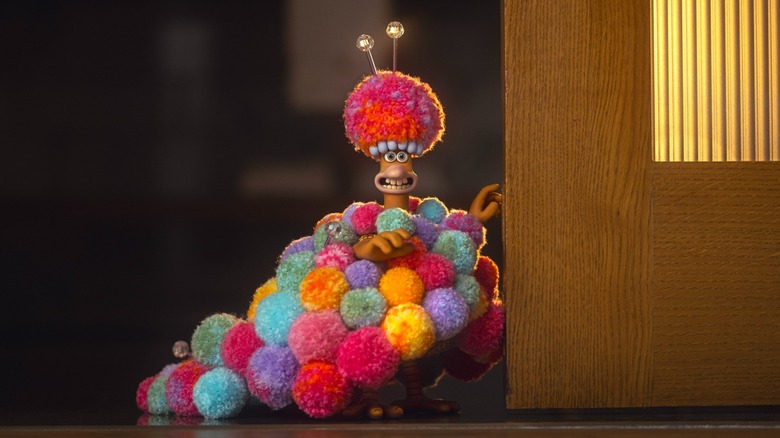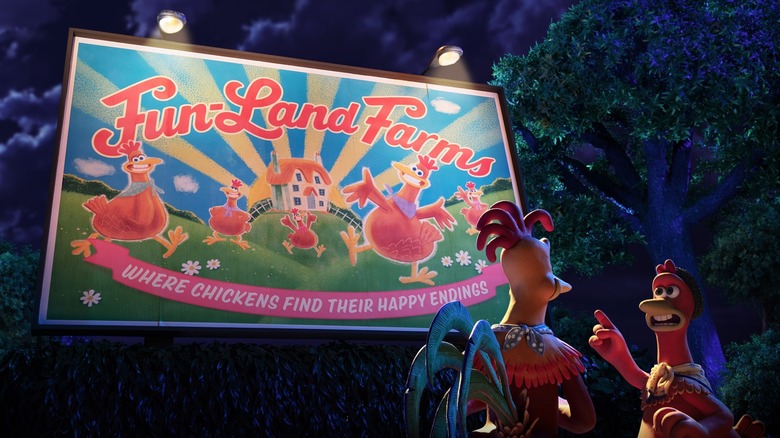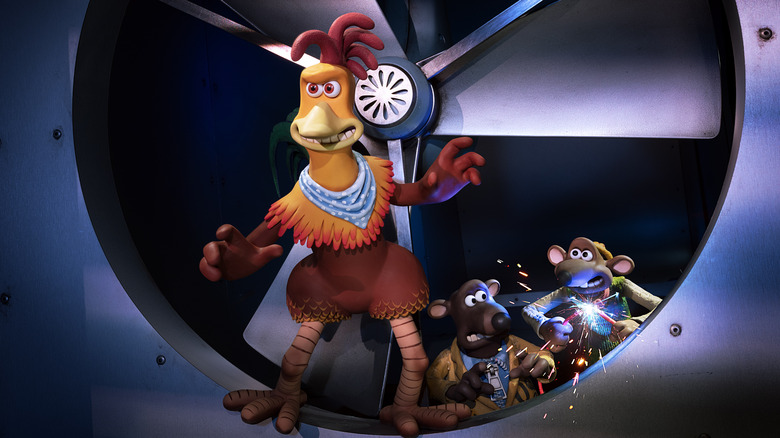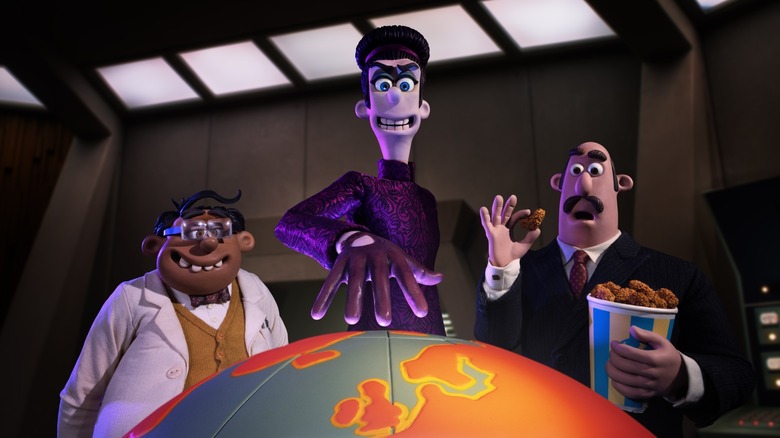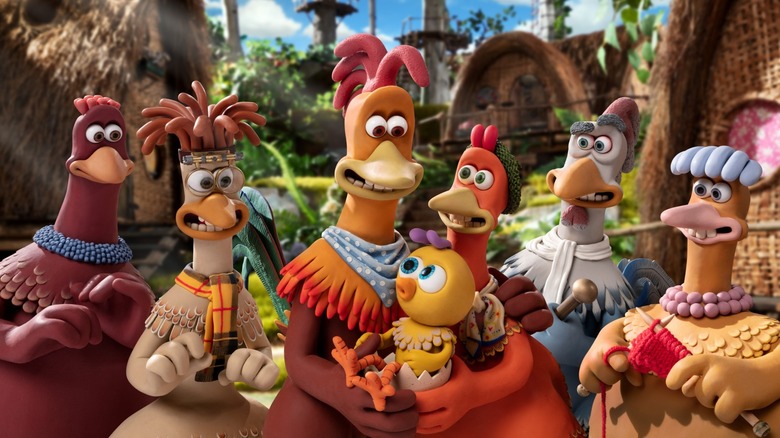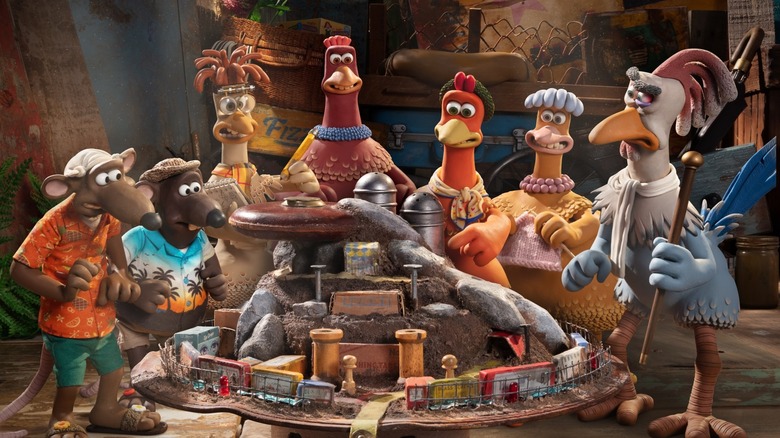How Dawn Of The Nugget Director Sam Fell Brought Chicken Run Into The Swinging Sci-Fi '60s [Exclusive Interview]
The revolting poultry of "Chicken Run" thought that their darkest days were behind them after escaping from Tweedy's Farm in Aardman Animation's daring stop-motion prison break, "Chicken Run." In the 2023 sequel, "Chicken Run: Dawn of the Nugget," even the fierce and fearless leader Ginger is willing to turn a blind eye to the suffering of chickens on other farms, for the sake of preserving an idyllic new existence in their island chicken sanctuary.
Between finding her dream home and becoming a mother, Ginger suddenly has a lot of reasons to be afraid. She and Rocky hatch an adorable chick, Molly, who inherits her parents' love of freedom and daredevil antics. But when Molly's free spirit leads her off the island and into the path of the villainous Mrs. Tweedy, who has concocted a sinister new business model for chicken farming, Ginger has to face her fears and break into Fun-Land Farms to free her feathered offspring.
Ahead of the release of "Chicken Run: Dawn of the Nugget," I spoke to director Sam Fell about evolving the story into something new, revisiting the casting process, and, of course, Mrs. Tweedy's killer sixties fashion makeover.
Note: This interview has been lightly edited for clarity and brevity.
'Fun-Land Farms is the dark side of the idea'
There's a very clear generational story this time around. Ginger being a mother really affects — in the first film, she wasn't afraid of anything. She was just, "Let's go for it, let's do it. Even if we die trying." She's not so much like that this time around.
No, there's a vulnerability to having a kid that everybody ... I think that's universal. But certainly for her, I think it's probably a surprise, actually, because she's tough. And as you said, you put it perfectly, she had nothing to lose when she was younger. So yeah, I think it's a surprise to her, the whole thing is a surprise to her. That she's not on top of everything anymore and that Molly's a chick off the old block.
There is a sequence right at the start where Molly is just making a beeline for danger in every situation, which I think is relatable for a lot of parents.
It's very relatable to me. My son particularly desired danger as he was growing up. [laughs] He was hanging off balconies and sticking his fingers in electric [sockets], running across roads without looking. So yes, it is. But I think for [Ginger], it's a shock because she worked so hard to win freedom and that island, to her, means everything. It means freedom. It's the thing she longed for through the whole [first] movie was that place. So to her, she couldn't see why anyone wouldn't want to live there forever. And to her, it's the thing that she's worked really hard to provide to Molly — freedom, this place — for Molly. And then for Molly to not want to be there forever and for Molly to kind of reject it? It's really hard for her, because we saw in the first [film] how much it mattered to her.
It's interesting how Fun-Land Farms is almost kind of an artificial version of the chicken sanctuary. Was that on purpose, that you tried to create that parallel?
Yeah. Quite deliberately. That's an underlying theme of happiness. "What is your happy ending?" Originally, it was called Happy-Land Farms, but we couldn't go there for legal reasons because so many food producers use "happy" in their branding that it was just a minefield. So yeah, it was definitely a parallel and a kind of shadow side. Obviously, the island at the beginning is paradise and it is Chicken Wakanda, I say. It's the perfect place for them to be living. But yeah, Fun-Land Farms is the dark side of the idea.
And then in the long run, it turns out that's not Ginger's happy ending at the beginning. She might think it is, but in the end, actually, her happy ending is — there's no such thing as a happy ending, I guess we're saying. But in the end, her happy place is to be engaging with the outside world with her family by her side, and with Molly by her side. And actually going out into the world. Because she's an activist, to be honest, Ginger. She's not really the sort of person that's going to retire quietly.
'Chicken: Impossible'
The first film was kind of very influenced by — "The Great Escape" was probably the main reference point. Were there particular action movies or heist movies that you referenced in this one?
We called it "Chicken: Impossible," actually, because it was ["Mission: Impossible"]. I'm such a fan of those movies and they're just brilliantly made, all of them. And I do love that sort of big Saturday night action movie experience. There's just something really cozy about it, especially if you're with your mates or your family, you're with people watching something like that. I don't know. So yeah, those were big. We looked at every single possible heist movie, the "Ocean's" films, and even the sort of indies, mad little things. "Palookaville" and those. There's a lot of them. "Baby Driver."
It's a good excuse to binge-watch lots of heist movies because you can say, "I'm researching for work."
I had a great time. It was just a great place to go, for Aardman especially, because it was a new place. It was a new kind of genre for Aardman, but all that sort of ingenuity that goes on, and the clever tricks and the gizmos, that just lends itself to Aardman already. The Aardman crew are so ingenious in the way they put things together and the scale of chickens to the human world. It just instantly gave us lots of visual humor.
But then obviously it was like a rescue movie really, because chickens don't care about money. They don't really steal diamonds, chickens. So we needed it to be something that really mattered. So it's more of a rescue movie.
My favorite gag in the movie is the eye scan where it looks like it's a high-tech operation, and then it's just [a guard slowly looking through a photo album of employees' irises].
Rubbish high-tech. Yeah, we kept that lo-fi thing. We never went super hi-fi sci-fi. And we looked at Jerry Anderson as well, like the "Thunderbirds" movies, for our special effects. All of our special effects were sort of influenced by those old-fashioned puppet live-action effects. We made sure the water looked like it had been shot in a bath rather than being a proper big fancy CGI lake and so all the splashes are the wrong scale, so it kind of felt like modern animation. But yeah, that was fun. And obviously it's sort of [James] Bond in the end, because the Dawn of the Nugget, this notion of the nuggets being this kind of apocalyptic event that would be meted on chickenkind — it just seemed very Bond scale, like "Moonraker," and the crazy madness of a Bond villain's idea.
'We actually started without Mrs. Tweedy'
Of course we've got a familiar face back, which is Mrs. Tweedy — a face that the chickens probably never hoped to see again. And she's got a new love in her life as well. So how did that relationship come about?
It was funny. It was a bit of a circuitous path in the development because we actually started without Mrs. Tweedy. And originally Dr. Fry was the original villain because the idea was like, "Oh, new movie, new villain." But as we were going along, he just didn't feel strong enough. I mean, honestly, he was a lot more serious than he is now, but he didn't feel strong enough. And it's always been this search, in this process, between what to keep from the first movie and what to change and how to evolve and make a new movie that's for a new audience and can stand on its own two feet and is its own thing.
But it just felt after a while that she was missing. I'd bump into ["Chicken Run" director] Nick Park in the studio and he would say, "Mrs. Tweedy ..." And then walk off. So it was in my mind, and then really what brought it about [was] when we really started focusing on Ginger as a main character and thinking about her and all aspects of her, and just how interesting it would be to have her haunted by Mrs. Tweedy in her subconscious. We looked at "Aliens." In the beginning of "Aliens," Ripley has nightmares about the alien and she doesn't want to go back down to the planet at first. So Ginger doesn't want to go off the island, but she has to in order to overcome her deepest, darkest fear that's haunting her. I think it gave the movie more depth and it made Ginger more interesting than just having some kind of other villain.
So we brought in Mrs. Tweedy and then it was like, "Oh wow, what fun to turn her into a supervillain. What fun to give her the makeover." And we went to the [Victoria and Albert Museum] and there's a Mary Quant exhibition on at the time.
And Dr. Fry, we needed a scientist to explain all of this mad science that's going on and that whole science fiction thing that comes from Bond. In the early '60s, which is when we are setting this time period, there was a lot of brainwashing stuff in movies and science fiction stuff. So we needed that scientist, we wanted to keep him. It just seemed natural and funny to make him her new husband because Mr. Tweedy just didn't seem to fit in any of this really, and I didn't want extra characters hanging around. So yeah, the implication is that maybe Mrs. Tweedy got a bit tired of Mr. Tweedy, maybe got rid of him.
She does seem to have a type...
[Dr. Fry is] similar. [laughs] He's exactly the same silhouette!
'I wanted to just evolve it into something new'
You've got some voices coming back from the first movie, and then some completely new characters to cast, and then some characters recast. So what was the general approach for casting for the sequel?
It's all part of the same creative development. It happens over a long period of time. No snap decisions were made, really. Initially I got a casting director to find Molly and Frizzle and obviously we lucked out and got Bella [Ramsey to play Molly]. And [Nick Mohammed for] Dr. Fry. Our casting director was working on [the] new characters. And then while we were there, we were kind of digging into Ginger more and more, and Rocky's position in the film was changing. Obviously the first movie is a two-hander of Rocky and Ginger, it's like a romantic comedy. But the story was shifting and Rocky was moving a little to the side, and then it was about Ginger and Molly.
So in that process, I said to our casting director, "Well, what if you were casting it now? What would you do with the cast now? I'm just interested, what would you do with all these roles, knowing where the story's going?" Because in parallel to this, it's always been, for me, a matter of ... I absolutely adore the first movie and I think it's brilliant. And the casting was brilliant and everything was brilliant about the first movie. But it's been a process of me trying to find a way to not be just completely in awe of it, because I didn't really want to just make a carbon copy of the first movie.
Yeah. Get out from under its shadow a bit.
Yeah, I wanted to just evolve it into something new. So she started sending me these lists of characters, and we looked at the whole cast. So Miranda [Richardson as Mrs. Tweedy] stuck. There were different names from Miranda, but honestly Miranda's got, for me, this handle on drama and comedy. In the same line, she can scare you and make you laugh. And I didn't see anyone else that could do that. And Miranda's from Stockport, which is more ... she has a northern sound.
It's quite a specific accent.
Yeah. And perfect. But then others ... Zachary Levi [who voices Rocky], I've been watching him and I really loved him in "Shazam." You have to remember, this is years ago when this [casting] is happening. So the first "Shazam" was kind of fresh, and I thought his timing and his charm and his delivery was just so fantastic. I just felt like he would make a good Rocky for me, for my story. And then same with Thandiwe [Newton, who plays Ginger]. I'd been watching her in "Westworld," and that strength and vulnerability that you mentioned earlier, I could see that in "Westworld" and I felt that complexity. And she's funny as well, Thandiwe. She gets the sense of humor.
'A lot of work went into those nuggets'
What was your favorite set out of the big sets that you built for this film?
Oh dear. That's tricky. There are three, but I would say I love the beauty of the island. I love making Chicken Wakanda and I love just turning that into paradise.
I love the name Chicken Wakanda. It's very apt.
It was just all the beautiful flowers and all of the beauty that went into the making of it. It's so gorgeous, what they did. I did like Fun-Land because it's got loads of chickens. It was just fun to do, the color, because that's unusual for "Chicken Run" to bring the color. And I really did like Mrs. Tweedy's staircase. I really enjoyed her entrance down that staircase. That took so much work.
I think my favorite might be the island, just because it's fun to look at all the little details.
How they live, all the little ... you could watch it and there's some chickens doing Tai Chi in the background. And there's a little swing and they've got all kinds of activities. There's a potato mine, I don't know if you saw that. They dig down and they get the potatoes out underground and there's a lot more besides.
You can make a whole nature documentary about this chicken sanctuary.
They made great vegetables in ["Wallace & Gromit: The Curse of the Were-Rabbit."] I was always impressed by the vegetable making, so I wanted giant vegetables, for sure.
Were you ever tempted to eat the vegetables on set?
[laughs] Well, they did look very tasty, I have to admit. But no, I became vegetarian during the making of the film because I couldn't face eating chicken.
I'm ashamed to say the nuggets do look very tasty.
There was a lot of work went into those nuggets. We had about 10 different versions, different glazes, different levels of crunchiness.
Hopefully no one will get a craving for nuggets after seeing the film.
Well, I think it's going to be hard to stop people. But yeah, maybe a few people will start thinking a bit more like a chicken by the end of it.
"Chicken Run: Dawn of the Nugget" is available now on Netflix.
